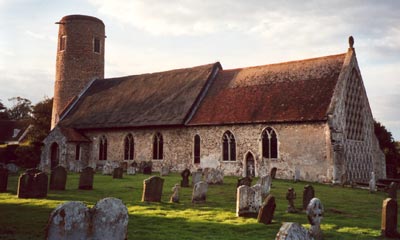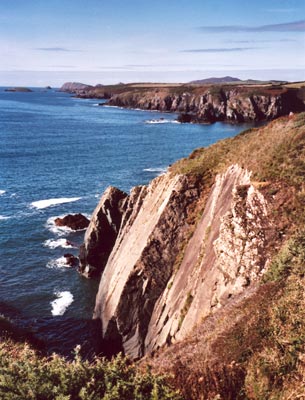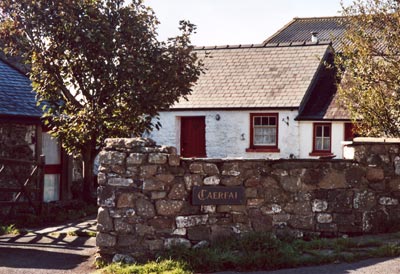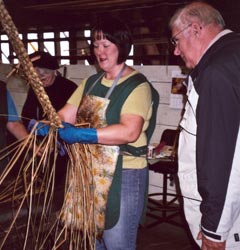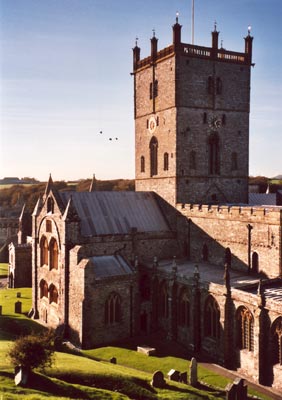St. Davids, Wales, & Beccles, England — a look at two small-town destinations
by Marisue Pickering, Orono, ME
Regular visits to our son and his family in England have allowed us to explore numerous parts of the British Isles. Our trip in the fall of 2006 took us to two new places: St. Davids in southwest Wales and Beccles, near the North Sea, in England.
St. Davids
Our pattern is to spend a long weekend with our family, then go off on our own for a few days. Our first independent excursion during this trip took us to St. Davids, Wales, a sparsely populated cathedral city that quickly enveloped us in its mystique.
Known as Wales’ spiritual center, this is where St. David, Wales’ patron saint, established a monastic community in the sixth century. St. Davids is located on a storm-battered peninsula that juts into the Irish Sea.
We arrived in St. Davids on a beautiful Monday in late September, having taken a London train to Haverfordwest, where we caught a local bus to St. Davids. The train trip required changes in Reading and Swansea.
We stayed at the Alandale Guest House (phone +44 [0] 1 437 720404, www.stdavids.co.uk/guesthouse/alandale.htm), which we had discovered on the Web. Alandale is a comfortable, well-run Victorian era B&B located near the center of St. Davids; from our room, we had a distant but lovely view of the water.
Our room price, which included a private bath and a full breakfast, was £65 a night (about $120 in September ’06).
First impression
The location of St. Davids makes a wonderful first impression. To begin with, the bus trip from Haverfordwest gave us magnificent views of the Irish Sea, the hills coming down to the shoreline, and the white beaches. The city itself is quite small, with buildings sitting close to the narrow streets.
The cathedral is tucked below a hill at the edge of town, which means it is not visible until the unsuspecting first-time visitor turns a corner — and there it is. And there it was for us, bathed in the clear afternoon sunlight. We were unprepared for the sheer beauty of the cathedral, the land and the sky.
Tuesday, another bright sunny day, was devoted to hiking around the windy headland of St. Davids Peninsula, where we had constant views of the water. This area is part of the Pembrokeshire Coast National Park, and the trail we took was perfectly maintained and not rigorous. We found the National Park Information Centre (The Grove, High St.) in St. Davids a good source for suggestions for walks geared to our level (and for purchasing maps, books and small gifts).
Legend is a major part of the charm of St. Davids. Stories tell of David being born on the headland where we hiked. Another legend is that St. Patrick sailed from one of the peninsula’s beaches to Ireland in the fifth century. Of course, we visited that beach also, taking the convenient “Celtic Coaster” bus (50 pence, around $1, per person) that does a loop of the area during the summer (May-September).
A bit of exploring
Wednesday was a day of intermittent rain, which gave us a chance to explore the inside of the cathedral and the nearby gatehouse, where there was a detailed historical exhibit and a most helpful docent. Parts of the cathedral date to the 12th century, but it has been rebuilt a number of times.
St. Davids was a major medieval pilgrimage site, with visitors apparently being attracted by the many legends associated with St. David and by the devotion attributed to the monastic community located within the cathedral close (grounds).
Thursday we again had good weather, so we wandered around the ruins of the once-magnificent 14th-century bishop’s palace adjacent to the cathedral. Apparently, St. Davids was the largest and most important diocese in medieval Wales, and the bishop’s palace reflected that importance.
We also explored the extensive cathedral grounds, obtaining a sense of the layout of medieval buildings, most of which no longer exist. We did find existing sections of the medieval close wall as well as some lovely gardens.
Leaving St. Davids
We left St. Davids on Friday, a day of truly heavy rain and strong winds — weather we had been told to expect this time of year. Our bus dropped us at the train station in Haverfordwest, and from there we traveled back toward London, with changes at Newport (Wales) and Reading.
Everything we had experienced in St. Davids seemed special, including the food. Near our B&B was a small café, The Sampler Coffee Shop (17 Nun St.), where we had homemade soup and bread plus Welsh cheese produced at a local dairy. Lunch was about £12 ($24) for two.
Also nearby was an elegant restaurant, Morgans Brassiere (20 Nun St.; www.morgans-restaurant.co.uk), that featured vegetarian specials as well as fish caught earlier that day. Dinner came to about £35 ($70) for two, with wine and tip.
We also had a good meal at the cathedral refectory. And our B&B hosts graciously catered to our vegetarian and fish preferences.
St. Davids is a treasure. It affords visitors stunning visual beauty, a sense of the history and legends of the area, a variety of walking/hiking options, delicious local food and a chance to learn about Wales. We were told St. Davids is full of visitors during the summer, but we encountered few others in late September. We would return in any season, however.
For more information on St. Davids, visit www.stdavids.co. uk.
Next stop, Beccles
Our second excursion was to visit friends in the old Suffolk town of Beccles, easily accessible via non-stop train from London. We had never heard of Beccles before our friends moved there and would not have visited were it not for them. We would have missed another treasure.
Located in the section of England known as East Anglia and situated on the River Waveney, Beccles is known as a market town, holding a weekly outdoor market and also providing goods and services for the surrounding area. (Its market was even noted in the Domesday Survey of 1086.)
We spent several hours in Beccles’ small shops, from the delicatessen owned by a Spanish immigrant to the very English knit shop where we found great socks to bring back home for our granddaughters.
Walking around Beccles was a treat, as it is full of old buildings and river views.
The Broads
Our friends took us to The Broads, which, as best as I understand it, is a network of inland waterways, now a wildlife sanctuary and major recreational area.
The Broads are composed of wide, shallow lakes interconnected by small streams and rivers, including the River Waveney, and incorporating bordering marshy areas as well.
On the edge of Oulton Broad is a most unusual cottage industry: The Waveney Rush Industry (www.waveneyrush.co.uk).
Our friends planned for us to spend part of a morning there watching crafters hand-weave rushes into floor coverings, baskets and place mats. The rushes are imported; sadly, the quality needed is no longer available in Britain, yet the craft is practiced as it has been in Britain for centuries.
For the floor mats, the workers (all women) basically make a 9-ply braid; braids are then sewn together to make whatever size of floor covering is required. We were told the mats sell for £149 ($296, plus tax) a square meter.
Our next stop was the town of Lowestoft and the edge of the North Sea, where we stood on “Britain’s most easterly point.” We did not linger long on this cold, rainy day, but being there helped us understand how close East Anglia is to the European continent.
A church side trip
Because our friends know we enjoy English church exploring, they made arrangements for us to visit a small parish church in the village of Barsham, outside Beccles. To our surprise, the parish priest devoted his afternoon to showing us around the church, first outside and then inside. He has lived in this area since 1938 and is truly an expert on “his” church, the Church of the Most Holy Trinity.
Among the features that caught our attention were the age of the church, the unusual stonework at the east end, the “plague pits” and the thatch roof, which has been replaced more than once.
We learned that church dating is often a difficult endeavor, but our guide’s opinion was that part of the church was constructed prior to 1066. Other parts of the church date to the 12th century. The east-end stonework is relatively new, probably from the 15th century, and the stonework’s stained glass is quite new, that is, from the 19th century.
Oral tradition suggests the presence of burial pits for 14th-century plague victims in one section of the churchyard.
Barsham’s church has another interesting feature: Lord Horatio Nelson’s mother was born in the church rectory. The church honors this connection by displaying signal flags of Nelson’s famous message prior to the 1805 Battle of Trafalgar: “England expects that every man will do his duty.”
We hope our friends remain in Beccles so we can visit them again; we found the area fascinating.

